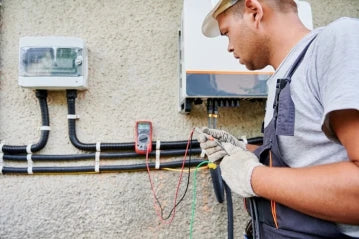
In recent years, the shift towards renewable energy has gained significant momentum, with solar power leading the charge. Solar systems are becoming increasingly popular among homeowners and businesses alike due to their environmental benefits and potential cost savings. However, many customers find themselves wondering how many batteries they need to complement their 4kW solar system. In this blog post, we'll delve into the world of solar batteries and help you understand the factors that will determine the optimal number of batteries for your solar setup.
1. Understanding Solar Systems: The Basics
Before we delve into the realm of batteries, let's start by understanding the core components of a solar system. A standard solar system consists of solar panels, an inverter, and a connection to the power grid. The solar panels, also known as photovoltaic (PV) panels, are responsible for converting sunlight into direct current (DC) electricity. The inverter, on the other hand, converts this DC electricity into alternating current (AC), which is the type of electricity used in our homes and businesses. The excess electricity generated by the solar system can be sent back to the grid or stored in batteries for later use.
2. The Role of Batteries in Solar Systems
Batteries play a crucial role in a solar system by acting as energy storage units. They allow homeowners and businesses to store excess electricity generated during sunny periods and use it during cloudy days or at night when the sun isn't shining. This capability is especially important for those looking to achieve energy independence and reduce their reliance on the grid.
3. Calculating Battery Requirements for a 4kW Solar System
Now that we understand the significance of batteries let's tackle the big question: how many batteries do you need for a 4kW solar system? The answer isn't as straightforward as a one-size-fits-all solution, as several factors come into play:
a. Energy Consumption
The first thing to consider is your energy consumption. How much electricity do you typically use in a day? Understanding your energy consumption patterns will give you an idea of the amount of energy you'll need to store in the batteries. Keep in mind that battery capacity is usually measured in kilowatt-hours (kWh).
b. Daily Sunlight Hours
The amount of sunlight your location receives is crucial. Areas with more sunlight hours will generate more solar energy, which means you'll require fewer batteries to store excess energy. On the other hand, regions with frequent cloudy days may necessitate more battery storage to ensure a reliable energy supply.
c. Load Shifting and Autonomy
Load shifting refers to the practice of using stored energy during peak demand periods or when grid electricity prices are higher. Autonomy, on the other hand, refers to the number of days your batteries can sustain your energy needs without solar input. Both factors impact the number of batteries you need. For instance, if you want to be self-sufficient during extended cloudy periods, you'll need a higher autonomy level, which means more batteries.
4. Battery Types and Technologies
There are different types of batteries available for solar systems, and each comes with its pros and cons:
a. Lead-Acid Batteries
Lead-acid batteries are a tried-and-tested technology, widely used in off-grid solar setups. They are cost-effective but have shorter lifespans compared to other battery types. Additionally, they require regular maintenance and should be installed in well-ventilated areas.
b. Lithium-Ion Batteries
Lithium-ion batteries have gained popularity due to their high energy density and longer lifespan. They require minimal maintenance and are often the preferred choice for grid-tied solar systems with battery backup. Though they are initially more expensive, their long-term benefits outweigh the cost.
c. Flow Batteries
Flow batteries are a newer technology gaining attention in the solar industry. They offer scalable storage options and have longer lifespans. However, they are still relatively expensive and not as widely available as other battery types.
5. Seeking Professional Guidance
As you can see, determining the number of batteries for your 4kW solar system is a complex process that requires a thorough analysis of your energy needs, location, and budget. To make an informed decision, it is highly recommended to consult with a reputable solar installer or energy expert. They can perform a detailed energy assessment and guide you in selecting the right battery type and capacity that aligns with your goals and requirements.
Conclusion
Embracing solar energy with a 4kW solar system is a commendable step towards sustainability and energy independence. However, to make the most of your solar investment, incorporating batteries into your setup is essential. The number of batteries you need depends on your energy consumption, sunlight availability, and desired autonomy level. Remember, each solar installation is unique, so seeking professional guidance will ensure that your solar system, complemented by the right battery technology, powers your journey towards a greener and brighter future.
Embrace the Power of Solar and Unleash the Potential of Batteries!

0 comments